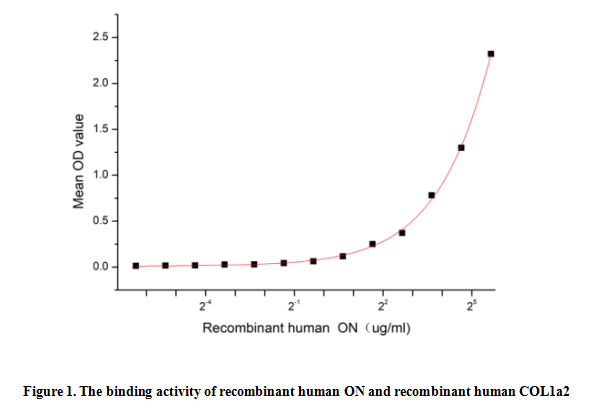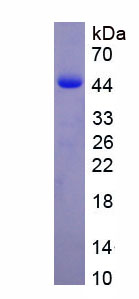Active Osteonectin (ON)
SPARC; BM-40; Secreted Protein,Acidic,Cysteine-Rich; Basement-membrane protein 40; Secreted protein acidic and rich in cysteine
- Product No.APA791Hu61
- Organism SpeciesHomo sapiens (Human) Same name, Different species.
- Buffer FormulationPBS, pH7.4, containing 5% Trehalose.
- Traits Freeze-dried powder
- Purity> 95%
- Isoelectric Point4.4
- ApplicationsCell culture; Activity Assays.
- DownloadInstruction Manual
- UOM 10µg50µg 200µg 1mg 5mg
- FOB
US$ 140
US$ 350
US$ 700
US$ 2100
US$ 5250
For more details, please contact local distributors!
ACTIVITY TEST

SPARC, also known as osteonectin(ON), is the founding member of a family of secreted matricellular proteins with similar domain structure. The 302 amino acid (aa), 43 kDa protein contains a 17 aa signal sequence, an N-terminal acidic region that binds calcium, a follistatin domain containing Kazal-like sequences, and a C-terminal extracellular calcium (EC) binding domain with two EF-hand motifs. SPARC is produced by fibroblasts, capillary endothelial cells, platelets and macrophages, especially in areas of tissue morphogenesis and remodeling. SPARC shows context-specific effects, but generally inhibits adhesion, spreading and proliferation, and promotes collagen matrix formation. Besides, Collagen Type I Alpha 2 (COL1a2)) has been identified as an interactor of SPARC, thus a functional binding ELISA assay was conducted to detect the interaction of recombinant human SPARC and recombinant human COL1a2. Briefly, SPARC was diluted serially in PBS with 0.01% BSA (pH 7.4). Duplicate samples of 100 μl were then transferred to COL1a2-coated microtiter wells and incubated for 1h at 37℃. Wells were washed with PBST and incubated for 1h with anti-SPARC pAb, then aspirated and washed 3 times. After incubation with HRP labelled secondary antibody for 1h at 37℃, wells were aspirated and washed 5 times. With the addition of substrate solution, wells were incubated 15-25 minutes at 37℃. Finally, add 50 µL stop solution to the wells and read at 450/630 nm immediately. The binding activity of recombinant human SPARC and recombinant human COL1a2 was shown in Figure 1, and this effect was in a dose dependent manner.
USAGE
Reconstitute in 10mM PBS (pH7.4) to a concentration of 0.1-1.0 mg/mL. Do not vortex.
STORAGE
Avoid repeated freeze/thaw cycles. Store at 2-8°C for one month. Aliquot and store at -80°C for 12 months.
STABILITY
The thermal stability is described by the loss rate. The loss rate was determined by accelerated thermal degradation test, that is, incubate the protein at 37°C for 48h, and no obvious degradation and precipitation were observed. The loss rate is less than 5% within the expiration date under appropriate storage condition.
GIVEAWAYS
INCREMENT SERVICES
-
 BCA Protein Quantification Kit
BCA Protein Quantification Kit
-
 Molecular Mass Marker for Protein
Molecular Mass Marker for Protein
-
 Monoclonal Antibody Customized Service
Monoclonal Antibody Customized Service
-
 Polyclonal Antibody Customized Service
Polyclonal Antibody Customized Service
-
 Protein Activity Test Experiment Service
Protein Activity Test Experiment Service
-
 Electrophoretic Mobility Shift Assay (EMSA) Experiment Service
Electrophoretic Mobility Shift Assay (EMSA) Experiment Service
-
 Buffer
Buffer
-
 Lentivirus Packaging Experiment Service
Lentivirus Packaging Experiment Service
-
 Adenovirus Packaging Experiment Service
Adenovirus Packaging Experiment Service
-
 Real Time PCR Experimental Service
Real Time PCR Experimental Service
-
 Spike RBD Protein (S-RBD)
Spike RBD Protein (S-RBD)
-
 Protein G
Protein G
-
 Protein A
Protein A
| Magazine | Citations |
| J Mol Med (Berl) | Growth hormone replacement therapy regulates microRNA-29a and targets involved in insulin resistance PubMed: 26199111 |
| Muscle Nerve | Effect of resistance ladder training on SPARC expression in skeletal muscle of hindlimb immobilized rats PubMed: 26467437 |
| Medicine (Baltimore) | An Attempt to Evaluate Selected Aspects of “Bone–Fat Axis” Function in Healthy Individuals and Patients With Pancreatic Cancer PubMed: 26266370 |
| British Journal of Cancer | A proteomics-based approach identifies secreted protein acidic and rich in cysteine as a prognostic biomarker in malignant pleural mesothelioma Pubmed:26889976 |
| Journal of diabetes and its complications | Associations between FGF21, osteonectin and bone turnover markers in type 2 diabetic patients with albuminuria. pubmed:27916484 |
| American journal of the medical sciences | Association of Bone Metabolic Markers With Diabetic Retinopathy and Diabetic Macular Edema in Elderly Chinese Individuals With Type 2 Diabetes Mellitus pubmed:29078839 |
| Translational Research in Oral Oncology | Testican 1 (SPOCK1) and protein tyrosine phosphatase, receptor type S (PTPRS) show significant increase in saliva of tobacco users with oral cancer Doi: 10.1177/2057178X18800534 |
| [ENGINEERING OF BIOMATERIALS | Osteoconductive potential of PLGA/bioglass composite biomaterials |
| Catalog No. | Related products for research use of Homo sapiens (Human) Organism species | Applications (RESEARCH USE ONLY!) |
| APA791Hu01 | Active Osteonectin (ON) | Cell culture; Activity Assays. |
| EPA791Hu61 | Eukaryotic Osteonectin (ON) | Positive Control; Immunogen; SDS-PAGE; WB. |
| APA791Hu61 | Active Osteonectin (ON) | Cell culture; Activity Assays. |
| RPA791Hu01 | Recombinant Osteonectin (ON) | Positive Control; Immunogen; SDS-PAGE; WB. |
| CPA791Hu21 | OVA Conjugated Osteonectin (ON) | Immunogen; SDS-PAGE; WB. |
| PAA791Hu01 | Polyclonal Antibody to Osteonectin (ON) | WB; IHC; ICC; IP. |
| PAA791Hu08 | Polyclonal Antibody to Osteonectin (ON) | WB; IHC; ICC; IP. |
| LAA791Hu81 | FITC-Linked Polyclonal Antibody to Osteonectin (ON) | WB; IHC; ICC; IF. |
| LAA791Hu71 | Biotin-Linked Polyclonal Antibody to Osteonectin (ON) | WB; IHC; ICC. |
| MAA791Hu22 | Monoclonal Antibody to Osteonectin (ON) | WB; IHC; ICC; IP. |
| SEA791Hu | ELISA Kit for Osteonectin (ON) | Enzyme-linked immunosorbent assay for Antigen Detection. |
| LMA791Hu | Multiplex Assay Kit for Osteonectin (ON) ,etc. by FLIA (Flow Luminescence Immunoassay) | FLIA Kit for Antigen Detection. |
| KSA791Hu01 | ELISA Kit DIY Materials for Osteonectin (ON) | Main materials for "Do It (ELISA Kit) Yourself". |







